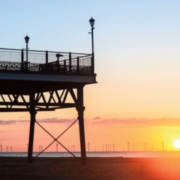East Lindsey District Council and the three beached sperm whales
Despite having significant experience at removing whales from beaches, all of us at East Lindsey District Council were shocked and saddened to wake up on Sunday 24th January and find that three of the magnificent mammals had come ashore in Skegness.
The news followed reports from a couple of days previously that a sperm whale had become stranded at Hunstanton, just down the coast. It seems that more members of the whale pod were in the North Sea – a significant distance from their usual home in the deep oceans. One whale came ashore close to the resort’s main beach, whilst the other two washed up further south on an area of special scientific interest, close to the Gibraltar Point Nature Reserve.
Though all anybody could do was speculate as to why this tragic phenomenon had occurred, it was a situation that the Council had to deal with quickly. As such, we were soon busy working with HM Coastguard and the Receiver of Wreck (who has a responsibility for ‘Royal Fish’ that come ashore such as whales, dolphins, porpoises and sturgeon), focusing on putting immediate plans in place to respectfully remove and dispose of the whales.
These plans were swiftly put into action, as this tragic situation wasn’t entirely new to us; in 2006, East Lindsey DC saw two Bottlenose Whales beached in Skegness. They were re-floated, only to come lifelessly back ashore the following day. Again, in 2012 a large sperm whale, slightly bigger than the recent whales, came ashore just north of the Pier. This whale was removed using a similar method to the one we used this January, so we knew very clearly what to do when this situation arose.
On Monday, the day after the whales had come ashore, the Zoological Society of London arrived in Skegness to undertake post mortem examinations on the three whales, in an attempt to understand how they’d come to arrive in the North Sea, and to determine the cause of death. By this point, we had also informed the Marine Management Organisation of the incident, and liaised with Natural England, as two of the whales beached on land of special scientific interest.
We appointed a contractor, Welton Aggregates, to carry out the removal and to take the whales on their final journey; in a discussion with the Receiver of Wreck, it was decided that moving the whales whole was our most appropriate and respectful option. Alongside this, we had to acquire a movement license to transport the whales to a site in Sheffield. Once all of these necessary steps had been taken, we were able to make preparations to move the bodies.
Around midday on Tuesday, we moved heavy machinery into Skegness, including an excavator, bull dozer and a wheeled loader. Due to the total weight – approximately 30 tonnes per whale – moving the whales, even with this sort of equipment, would take some time.
Health and safety was a key consideration for us and our contractors moved all three whales in a slow and careful process to the middle of central beach, where they were temporarily buried in mounds of sands. This move was important because we were concerned that the high tide could have lifted the whales and taken them out to sea, re-beaching them at a location that would make their already difficult removal much harder.
We moved the whales on Wednesday evening. Health and safety throughout this operation was a major part of the planning, given the location and the type of equipment being used. We used coastguards and police to keep the public safe, and chose to move the bodies later on in the evening, in order to avoid attracting a crowd. In an operation lasting six hours and starting at 7.30pm, we began loading the whales, one by one, onto extended low loader trailers, and we covered them in tarpaulin, ready to be taken to their final place of rest.
In a last minute change of plan, the whales, which were initially due to go to a landfill site for burial, were sent for rendering at a plant in the Sheffield area.
We were very clear from the outset that we wanted to treat the three whales with great respect during any operation to remove them. The reality is that you can’t get away from needing to use heavy machinery, but we wanted to take the carcasses to their final resting place whole, rather than undertake a grisly and less dignified removal.
This situation was different to others we’d dealt with as it is rare to find three beached whales at one time. International media attention immediately turned to Skegness; many major news outlets sent journalists, film cameras, photographers and even helicopters to the area. We decided to utilise this coverage in a bid to keep the public informed at a safe distance. Sky News did a live broadcast showing the loading and transportation of the whales, with BBC News, ITN and local media also showing huge interest in the operation. In this way, we were able to keep the majority of people away from the beach.
What really touched us all during this process was the great sense of sadness and loss that many people in Skegness and from much further afield felt. This is something that hadn’t been so apparent when this had happened previously. So many people from across the country came to our beach, as a mark of respect to the whales. One family from Nottingham brought their daughter, who wants to be a Marine Biologist, as they thought this could be a once in a lifetime opportunity for her to see a whale so close. There was a sense of sorrow and empathy, not only from those in our Council team but also from people in the wider community.
Though it was an upsetting time, we are pleased that we had the knowledge to offer these whales the respect and dignity they deserved. We would also like other local authorities to know that we are available to offer more information, guidance and help to any Council who finds themselves in this situation or something similar.
To contact James, email [email protected].


.png)



.png)